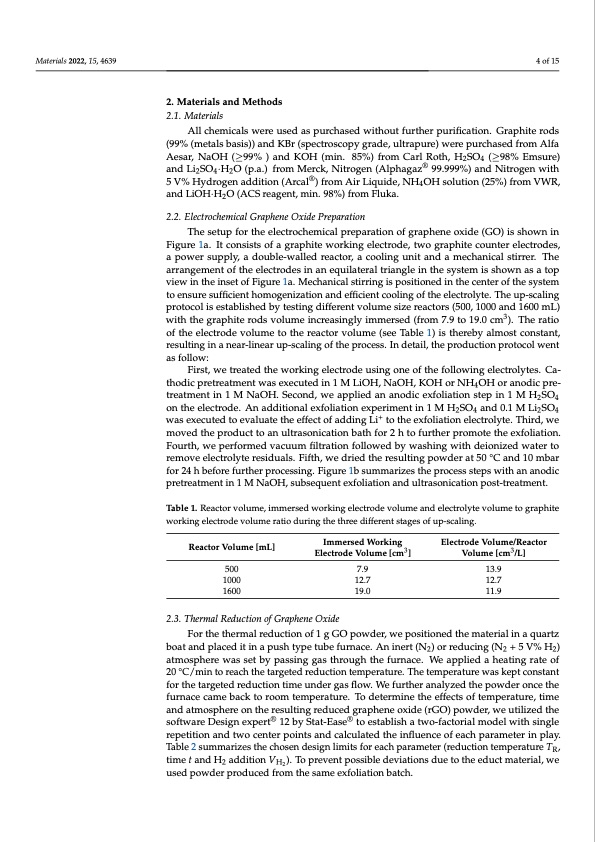
PDF Publication Title:
Text from PDF Page: 004
Materials 2022, 15, 4639 4 of 15 2. Materials and Methods 2.1. Materials All chemicals were used as purchased without further purification. Graphite rods (99% (metals basis)) and KBr (spectroscopy grade, ultrapure) were purchased from Alfa Aesar, NaOH (≥99% ) and KOH (min. 85%) from Carl Roth, H2SO4 (≥98% Emsure) and Li2SO4·H2O (p.a.) from Merck, Nitrogen (Alphagaz® 99.999%) and Nitrogen with 5 V% Hydrogen addition (Arcal®) from Air Liquide, NH4OH solution (25%) from VWR, and LiOH·H2O (ACS reagent, min. 98%) from Fluka. 2.2. Electrochemical Graphene Oxide Preparation The setup for the electrochemical preparation of graphene oxide (GO) is shown in Figure 1a. It consists of a graphite working electrode, two graphite counter electrodes, a power supply, a double-walled reactor, a cooling unit and a mechanical stirrer. The arrangement of the electrodes in an equilateral triangle in the system is shown as a top view in the inset of Figure 1a. Mechanical stirring is positioned in the center of the system to ensure sufficient homogenization and efficient cooling of the electrolyte. The up-scaling protocol is established by testing different volume size reactors (500, 1000 and 1600 mL) with the graphite rods volume increasingly immersed (from 7.9 to 19.0 cm3). The ratio of the electrode volume to the reactor volume (see Table 1) is thereby almost constant, resulting in a near-linear up-scaling of the process. In detail, the production protocol went as follow: First, we treated the working electrode using one of the following electrolytes. Ca- thodic pretreatment was executed in 1 M LiOH, NaOH, KOH or NH4OH or anodic pre- treatment in 1 M NaOH. Second, we applied an anodic exfoliation step in 1 M H2SO4 on the electrode. An additional exfoliation experiment in 1 M H2SO4 and 0.1 M Li2SO4 was executed to evaluate the effect of adding Li+ to the exfoliation electrolyte. Third, we moved the product to an ultrasonication bath for 2 h to further promote the exfoliation. Fourth, we performed vacuum filtration followed by washing with deionized water to remove electrolyte residuals. Fifth, we dried the resulting powder at 50 °C and 10 mbar for 24 h before further processing. Figure 1b summarizes the process steps with an anodic pretreatment in 1 M NaOH, subsequent exfoliation and ultrasonication post-treatment. Table 1. Reactor volume, immersed working electrode volume and electrolyte volume to graphite working electrode volume ratio during the three different stages of up-scaling. Reactor Volume [mL] 500 1000 1600 2.3. Thermal Reduction of Graphene Oxide 7.9 12.7 19.0 Immersed Working Electrode Volume [cm3] Electrode Volume/Reactor Volume [cm3/L] 13.9 12.7 11.9 For the thermal reduction of 1 g GO powder, we positioned the material in a quartz boat and placed it in a push type tube furnace. An inert (N2) or reducing (N2 + 5 V% H2) atmosphere was set by passing gas through the furnace. We applied a heating rate of 20 °C/min to reach the targeted reduction temperature. The temperature was kept constant for the targeted reduction time under gas flow. We further analyzed the powder once the furnace came back to room temperature. To determine the effects of temperature, time and atmosphere on the resulting reduced graphene oxide (rGO) powder, we utilized the software Design expert® 12 by Stat-Ease® to establish a two-factorial model with single repetition and two center points and calculated the influence of each parameter in play. Table 2 summarizes the chosen design limits for each parameter (reduction temperature TR, time t and H2 addition VH2 ). To prevent possible deviations due to the educt material, we used powder produced from the same exfoliation batch.PDF Image | Electrochemical Production Thermal Reduction Graphene Oxide

PDF Search Title:
Electrochemical Production Thermal Reduction Graphene OxideOriginal File Name Searched:
materials-15-04639.pdfDIY PDF Search: Google It | Yahoo | Bing
Salgenx Redox Flow Battery Technology: Power up your energy storage game with Salgenx Salt Water Battery. With its advanced technology, the flow battery provides reliable, scalable, and sustainable energy storage for utility-scale projects. Upgrade to a Salgenx flow battery today and take control of your energy future.
| CONTACT TEL: 608-238-6001 Email: greg@infinityturbine.com | RSS | AMP |